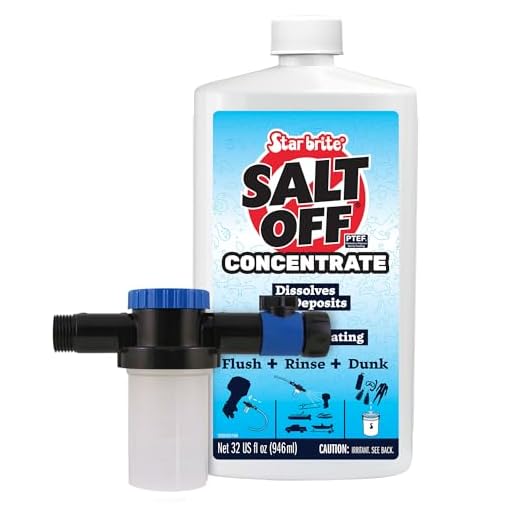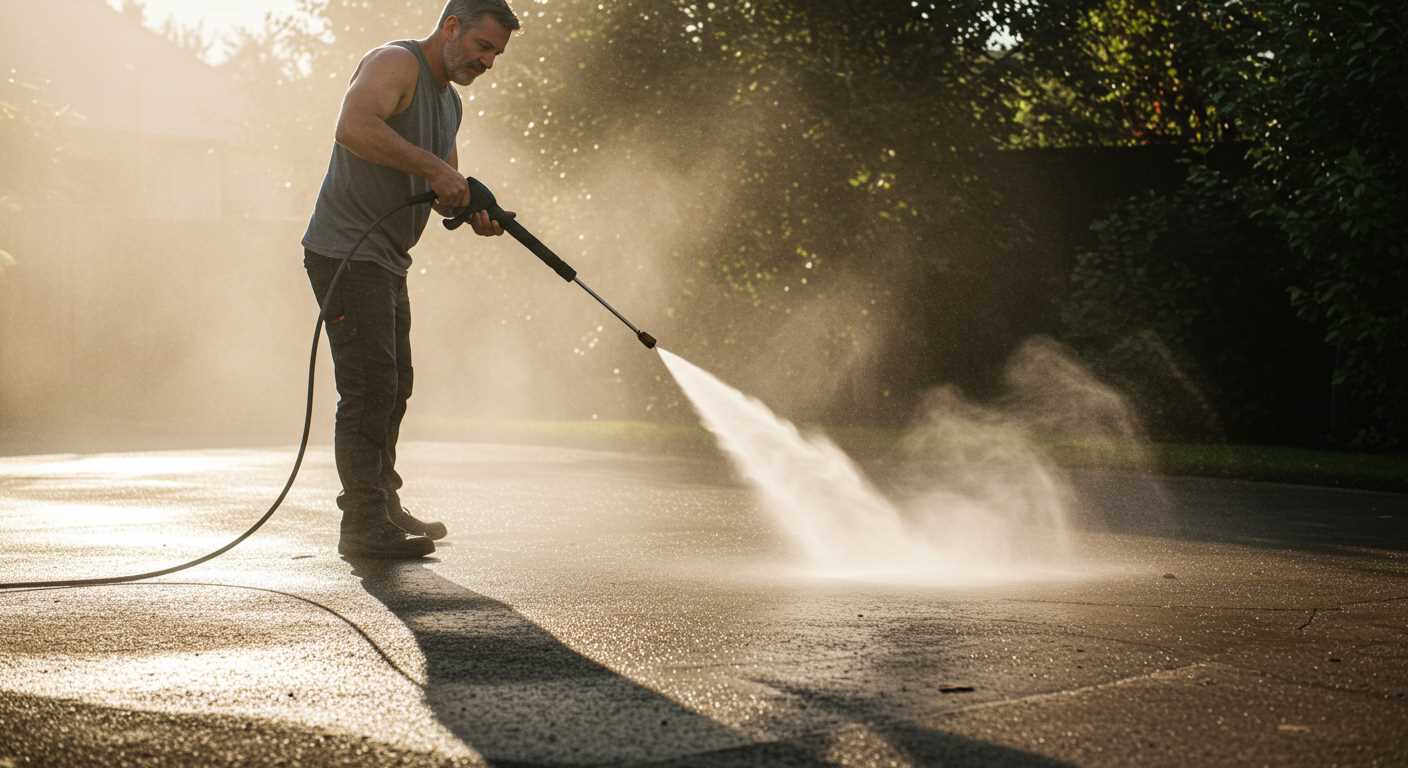



Begin by selecting an appropriate nozzle; a 25-degree or 40-degree tip is ideal for wooden surfaces, as it prevents damage while ensuring thorough removal of grime and moss. Always maintain a distance of approximately 2 feet from the surface to avoid gouging.
Prior to operation, inspect the area for loose boards and protruding nails. Secure any loose fittings to prevent accidents during the cleaning session. It’s wise to use a broom or leaf blower to clear away debris that could impede the process.
Applying a suitable cleaning solution can significantly enhance results. Look for products specifically designed for wood, ensuring they are compatible with your equipment. Allow the solution to penetrate the surface for a few minutes before rinsing with the high-pressure device. This ensures that dirt and stains are lifted effectively.
As you operate the high-pressure cleaner, employ a sweeping motion, working systematically from one end to the other. This technique not only optimises efficiency but also guarantees consistent outcomes across the entire surface. Pay attention to areas that may require additional passes.
Finish by rinsing thoroughly to eliminate any remaining cleaning solution, ensuring a safe and sound environment for both the decking and those who enjoy the area. Regular maintenance after each season can prolong the life and aesthetics of your outdoor space.
Pressure Washing Tips for Deck Maintenance

Use a fan tip nozzle for even dispersion, ensuring a gentle yet effective approach. Maintain a distance of approximately 20-30 cm from the surface to prevent damage. Select a pressure setting around 1200–1500 PSI for softer woods, while harder materials like composite can tolerate higher settings.
Follow these steps for optimal results:
- Begin by sweeping the area thoroughly to remove debris, leaves, and dirt.
- Wet the surface lightly to prepare it.
- Apply a suitable cleaning solution designed for outdoor furniture surfaces and allow it to dwell for the specified time. This aids in breaking down stubborn stains.
- Starting from one end, work systematically across the area using a back-and-forth motion. Overlap each pass to ensure complete coverage.
- Rinse the surface well once all areas have been treated to eliminate any residue from cleaning agents.
Consider the weather conditions; it’s best to avoid rinsing when the sun is directly shining on the surface, as this can lead to streaks and a less thorough clean. After rinsing, allow it to dry completely before applying any sealers or protective treatments.
Lastly, take care of your equipment. Clean your nozzle after each use to prevent clogs, and store it in a dry place to extend its lifespan.
Choosing the Right Pressure Washer for Your Decking
Opt for an electric model for lighter tasks or a gas variant for tougher grime removal. Electric units generally offer 1200 to 2000 PSI, ideal for regular maintenance, while gas counterparts deliver up to 4000 PSI, suitable for deep cleaning and removal of stubborn stains.
Evaluate the flow rate as measured in gallons per minute (GPM); a higher GPM increases the volume of water used, reducing cleaning time. Combine at least 2.5 GPM with a suitable pressure for optimal results.
Look for adjustable nozzles to switch between tasks without hassle. A 25-degree nozzle works well for most surfaces, while a 40-degree option is preferred for more delicate finishes.
Consider the weight and manoeuvrability of the equipment. A machine with wheels or a compact design can simplify handling, particularly on uneven surfaces.
Assess the noise level; electric types typically operate quieter compared to gas models, making them suitable for residential areas without disturbing neighbours.
Check for additional features such as detergent tanks which can help when needing extra power for tough spots, along with safety features like automatic shut-off systems.
Finally, read reviews and seek recommendations based on personal experiences to ensure you’re selecting a reliable machine that suits your needs.
Preparing Your Decking Area Before Cleaning
Remove all furniture, pots, and decorative items from the surface. This ensures a clear working space, preventing damage to your belongings during the process.
Inspect for any loose boards or protruding nails. Make necessary repairs to avoid accidents while operating the equipment.
Clear away debris such as leaves, dirt, and grime that may obstruct the cleaning process. A broom or blower works well to prepare the area effectively.
If applicable, cover nearby plants or shrubs to protect them from high-pressure water splashes or any cleaning solutions you might use.
Consider applying a suitable protective sealant once the surface has dried after cleaning. This adds an extra layer of defence against future weathering.
Check the local weather forecast to ensure favourable conditions, avoiding high winds or rain that could interfere with the task at hand.
Gather all necessary equipment and safety gear, including protective eyewear and gloves, ensuring you’re ready to tackle the job efficiently.
Picking the Appropriate Cleaning Solution for Decking
Select a cleaning solution based on the material of the surface. For wood, opt for a biodegradable cleaner that penetrates the grain without causing harm. A sodium percarbonate solution works well for stains and dirt removal, ensuring it is safe for treated wood.
For composite surfaces, look for a solution specifically designed for that material. These typically contain agents that remove grime without damaging the surface. Avoid bleach-based products, as they can lead to fading and discolouration.
If mould and mildew are concerns, choose a product containing a mildewcide. Ensure it’s appropriate for outdoor use and follow dilution ratios stated on the packaging for effective results.
Always check for compatibility with your cleaning device. Some solutions may require different pressure settings or nozzle types, impacting performance. Pre-testing a small, inconspicuous area with your chosen cleaner can help gauge effectiveness and safety.
In cases of heavy staining, consider a concentrated formula. These are designed for intense grime and may require less application time. Be cautious with application to prevent any potential surface damage.
Lastly, remember to read reviews and product specifications prior to purchasing. User experiences often highlight the strengths and weaknesses of specific cleaners, aiding in making an informed choice for optimal results.
Technique for Pressure Washing Your Deck
Set the nozzle to a wide fan pattern before starting. Keep a distance of around 30 cm from the surface to avoid damage while ensuring thorough coverage. Move the nozzle in a sweeping motion, overlapping each pass by about 50%. This promotes an even wash without streaks. Start from one end and gradually work your way across the area.
Angle and Movement
Maintain an angle of approximately 45 degrees as you spray. This angle aids in dislodging dirt and grime without forcing it deeper into the wood. Use a consistent, steady pace. Slower movements may lead to excessive wear, while rushing may leave spots unwashed.
Sectional Approach
Divide the area into smaller sections to manage the process efficiently. Clean one section at a time, allowing excess water to flow off and reduce puddling. Once the first section is complete, move on to the next, ensuring thorough cleaning throughout the task.
Post-Cleaning Care and Maintenance for Decking
.jpg)
After finishing the washing process, it’s essential to allow the surface ample time to dry completely. I recommend waiting at least 24 hours before placing any furniture back on the boards to prevent any potential damage. Ensure proper ventilation by keeping all surroundings clear for optimal air circulation.
Sealing the Surface

Applying a protective sealant is highly advisable post-cleaning. This step helps safeguard the boards from moisture, UV rays, and everyday wear. Opt for a high-quality sealant specifically designed for outdoor wood surfaces. A clear or tinted finish can enhance the boards’ appearance while offering protection. Follow the manufacturer’s instructions for application to achieve the best results.
Regular Inspection and Maintenance
Establish a routine to inspect the surface every few months. Look for signs of wear, such as splintering or cracking. If any areas show deterioration, undertake minor repairs swiftly. Sand down rough spots and treat them with a suitable wood preservative to prolong the lifespan of the structure. Additionally, a light brushing or vacuuming session monthly can help reduce debris accumulation, maintaining the surface’s appeal and safety.
Safety Tips When Using a Pressure Washer
Always utilise protective eyewear and sturdy footwear. This equipment shoots out water at high pressure, which can cause severe injuries if misdirected. Ensure your eyes and feet are shielded from any potential debris.
Proper Equipment Check
Inspect all connections and hoses for wear or damage before starting. Leaks or frayed hoses can lead to unexpected spray and malfunctions. It’s prudent to replace any damaged components immediately.
Safe Operating Distance
Maintain an appropriate distance from the surface being treated. Generally, a distance of 30 to 60 cm is advisable. Getting too close can cause gouging or surface damage.
| Safety Measure | Description |
|---|---|
| Protective Eyewear | Wear goggles or safety glasses to shield eyes. |
| Sturdy Footwear | Choose shoes with good traction to prevent slips. |
| Check Hoses | Look for leaks or damages before operation. |
| Maintain Distance | Keep 30-60 cm away from surfaces. |
| Secure Area | Clear surroundings of obstacles and bystanders. |
Avoid operating on wet ground to prevent slipping. Ensure the area is dry and free of obstacles, which can cause accidents while managing the equipment. Always be aware of your surroundings; secure the work area to ensure pets and children remain at a safe distance.
Always follow the manufacturer’s instructions for the specific model to prevent mishaps. Misuse of features or settings can lead to dangerous situations. Lastly, never point the nozzle at yourself or others, even when off, as accidents can happen quickly.









